Effects of Entropy Generation, Thermal Radiation and Moving-Wall Direction on Mixed Convective Flow of Nanofluid in an Enclosure
Abstract
1. Introduction
2. Mathematical Modeling
3. Cup Mixing Temperature and RMSD
4. Entropy Generation
5. Numeric Technique
6. Results and Discussion
7. Conclusions
- ○
- The moving-wall direction drastically affects the stream field inside the enclosure. Single and dual cell structures are formed in Case 1 and Case 2, respectively for all values of Ri, radiation parameter and all nanoliquids;
- ○
- The skin friction declines upon raising the values of the Richardson number for Case 1. It increases up to Ri = 1 and then decreases upon raising the Richardson number in Case 2;
- ○
- The higher local energy transport is attained at bottom of the heat wall for Case 1 and at top of the hot wall for Case 2 in the forced and mixed convective flow regimes. The free-convection mode provides a similar trend on both cases, that is, the highest heat transfer attains near the bottom of the barrier;
- ○
- The thermal radiation parameter enhances the energy transport across the enclosure for all given values of Ri and in both directions of the moving wall;
- ○
- The moving-wall direction greatly influences the energy transfer rate. The Case 1 (moving-wall from left to right) provides a higher heat transfer rate than that of Case 2 for all values of Ri and the radiation parameter;
- ○
- The averaged heat transport declines upon rising the volume fraction of nanoparticle in free and mixed convection regimes for both moving-wall directions. The averaged heat transport increases with the nanoparticles volume fraction in Case 1. It rises first and then declines upon raising the values of nanoparticles volume fraction in Case 2;
- ○
- The Bejan number enhances on raising the Rd values. Entropy generation dominates by thermal transfer;
- ○
- The lower values of RMSD in all cases illustrates the higher temperature uniformity inside the box;
- ○
- The Tcup and Tavg values are almost constant when changing the values of Rd in free-convection flow for Case 2. The cup-mixing temperature behaves non-linear fashion for Case 1 and almost a linear fashion for Case 2.
Author Contributions
Funding
Acknowledgments
Conflicts of Interest
References
- Alsabery, A.I.; Tayebi, T.; Roslan, R.; Chamkha, A.J.; Hashim, I. Entropy Generation and Mixed Convection Flow Inside a Wavy-Walled Enclosure Containing a Rotating Solid Cylinder and a Heat Source. Entropy 2020, 22, 606. [Google Scholar] [CrossRef]
- Chamkha, A.J.; Selimefendigil, F.; Oztop, H.F. MHD mixed convection and entropy generation in a lid-driven triangular cavity for various electrical conductivity models. Entropy 2018, 20, 903. [Google Scholar] [CrossRef]
- Bhuvaneswari, M.; Sivasankaran, S.; Kim, Y.J. Numerical Study on double diffusive mixed convection in a two-sided lid driven cavity with Soret effect. Numer. Heat Transf. Part A 2011, 59, 543–560. [Google Scholar] [CrossRef]
- Sivasankaran, S.; Cheong, H.T.; Bhuvaneswari, M.; Ganesan, P. Effect of moving wall direction on mixed convection in an inclined lid-driven square cavity with sinusoidal heating. Numer. Heat Transf. Part A 2016, 69, 630–642. [Google Scholar] [CrossRef]
- Mahmoudinezhad, S.; Rezania, A.; Yousefi, T. Adiabatic partition effect on natural convection heat transfer inside a square cavity: Experimental and numerical studies. Heat Mass Transf. 2018, 54, 291–304. [Google Scholar] [CrossRef]
- Selimefendigil, F.; Öztop, H.F.; Chamkha, A.J. Analysis of mixed convection of nanofluid in a 3D lid-driven trapezoidal cavity with flexible side surfaces and inner cylinder. Int. Commun. Heat Mass Transf. 2017, 87, 40–51. [Google Scholar] [CrossRef]
- Oztop, H.F.; Almeshaal, M.A.; Kolsi, L.; Rashidi, M.M.; Ali, M.E. Natural convection and irreversibility evaluation in a cubic cavity with partial opening in both top and bottom sides. Entropy 2019, 21, 116. [Google Scholar] [CrossRef]
- Safaei, M.R.; Shadloo, M.S.; Goodarzi, M.S.; Hadjadj, A.; Goshayeshi, H.R.; Afrand, M.; Kazi, S.N. A survey on experimental and numerical studies of convection heat transfer of nanofluids inside closed conduits. Adv. Mech. Eng. 2016, 8, 1687814016673569. [Google Scholar] [CrossRef]
- Chamkha, A.J.; Selimefendigil, F. MHD free convection and entropy generation in a corrugated cavity filled with a porous medium saturated with nanofluids. Entropy 2018, 20, 846. [Google Scholar] [CrossRef]
- Sivasankaran, S.; Sivakumar, V.; Hussein, A.K. Numerical study on mixed convection in an inclined lid-driven cavity with discrete heating. Int. Commun. Heat Mass Transf. 2013, 46, 112–125. [Google Scholar] [CrossRef]
- Sivasankaran, S.; Pan, K.L. Lattice Boltzmann simulation for a lid-driven cavity with discrete heating/cooling sources. AIAA J. Thermophys. Heat Transf. 2016, 30, 573–586. [Google Scholar] [CrossRef]
- Mekroussi, S.; Nehari, D.; Bouzit, M.; Chemloul, N.E.S. Analysis of mixed convection in an inclined lid-driven cavity with a wavy wall. J. Mech. Sci. Technol. 2013, 27, 2181–2190. [Google Scholar] [CrossRef]
- Sivakumar, V.; Sivasankaran, S. Mixed convection in an inclined lid-driven cavity with non-uniform heating on both sidewalls. J. Appl. Mech. Tech. Phys. 2014, 55, 634–649. [Google Scholar] [CrossRef]
- Sivasankaran, S.; Ananthan, S.S.; Abdul Hakeem, A.K. Mixed convection in a lid-driven cavity with sinusoidal boundary temperature at the bottom wall in the presence of magnetic field. Sci. Iran. Trans. B Mech. Eng. 2016, 23, 1027–1036. [Google Scholar] [CrossRef]
- Sivasankaran, S.; Ananthan, S.S.; Bhuvaneswari, M.; Abdul Hakeem, A.K. Double-diffusive mixed convection in a lid-driven cavity with non-uniform heating on sidewalls. Sadhana 2017, 42, 1929–1941. [Google Scholar] [CrossRef]
- Kasmani, R.M.D.; Sivasankaran, S.; Bhuvaneswari, M.; Hussein, A.K. Analytical and numerical study on convection of nanofluid past a moving wedge with Soret and Dufour effects. Int. J. Numer. Methods Heat Fluid Flow 2017, 27, 2333–2354. [Google Scholar] [CrossRef]
- Öztop, H.F.; Sakhrieh, A.; Abu-Nada, E.; Al-Salem, K. Mixed convection of MHD flow in nanofluid filled and partially heated wavy walled lid-driven enclosure. Int. Commun. Heat Mass Transf. 2017, 86, 42–51. [Google Scholar] [CrossRef]
- Rashidi, M.M.; Nasiri, M.; Shadloo, M.S.; Yang, Z. Entropy Generation in a Circular Tube Heat Exchanger Using Nanofluids: Effects of Different Modeling Approaches. Heat Transf. Eng. 2017, 38, 853–866. [Google Scholar] [CrossRef]
- Sivasankaran, S.; Narrein, K. Numerical investigation of two-phase laminar pulsating nanofluid flow in helical microchannel filled with a porous medium. Int. Commun. Heat Mass Transf. 2016, 75, 86–91. [Google Scholar] [CrossRef]
- Khashi’ie, N.S.; Md Arifin, N.; Pop, I. Mixed convective stagnation point flow towards a vertical riga plate in hybrid Cu-Al2O3/water nanofluid. Mathematics 2020, 8, 912. [Google Scholar] [CrossRef]
- Sheremet, M.A.; Grosan, T.; Pop, I. Natural convection and entropy generation in a square cavity with variable temperature side walls filled with a nanofluid: Buongiorno’s mathematical model. Entropy 2017, 19, 337. [Google Scholar] [CrossRef]
- Alsabery, A.I.; Ismael, M.A.; Chamkha, A.J.; Hashim, I. Numerical investigation of mixed convection and entropy generation in a wavy-walled cavity filled with nanofluid and involving a rotating cylinder. Entropy 2018, 20, 664. [Google Scholar] [CrossRef]
- Santra, A.K.; Sen, S.; Chakraborty, N. Study of heat transfer augmentation in a differentially heated square cavity using copper-water nanofluid. Int. J. Therm. Sci. 2008, 47, 1113–1122. [Google Scholar] [CrossRef]
- Abu-Nada, E.; Oztop, H.F. Effects of inclination angle on natural convection in enclosures filled with Cu-water nanofluid. Int. J. Heat Fluid Flow 2009, 30, 669–678. [Google Scholar] [CrossRef]
- Ghasemi, B.; Aminossadati, S.M. Natural convection heat transfer in an inclined enclosure filled with a water CuO nanofluid. Numer. Heat Transf. Part A 2009, 55, 807–823. [Google Scholar] [CrossRef]
- Bhuvaneswari, M.; Ganesan, P.; Sivasankaran, S.; Viswanathan, K.K. Effect of variable fluid properties on natural convection of nanofluids in a cavity with linearly varying wall temperature. Math. Probl. Eng. 2015, 2015, 391786. [Google Scholar] [CrossRef]
- Sivasankaran, S.; Mansour, M.A.; Rashad, A.M.; Bhuvaneswari, M. MHD mixed convection of Cu–water nanofluid in a two-sided lid-driven porous cavity with a partial slip. Numer. Heat Transf. Part A 2016, 70, 1356–1370. [Google Scholar] [CrossRef]
- Rashad, A.M.; Sivasankaran, S.; Mansour, M.A.; Bhuvaneswari, M. Magneto-convection of nanofluids in a lid-driven trapezoidal cavity with internal heat generation and discrete heating. Numer. Heat Transf. Part A 2017, 71, 1223–1234. [Google Scholar] [CrossRef]
- Mansour, M.A.; Abd El-Aziz, M.M.; Mohamed, R.A.; Ahmed, S.E. Numerical simulation of natural convection in wavy porous cavities under the influence of thermal radiation using a thermal non-equilibrium model. Transp. Porous Media 2011, 86, 585–600. [Google Scholar] [CrossRef]
- Moufekkir, F.; Moussaoui, M.A.; Mezrhab, A.; Bouzidi, M.; Lemonnier, D. Combined double diffusive convection and radiation in a square enclosure filled with semitransparent fluid. Comput. Fluids 2012, 69, 172–178. [Google Scholar] [CrossRef]
- Mahapatra, T.R.; Pal, D.; Mondal, S. Mixed convection flow in an inclined enclosure under magnetic field with thermal radiation and heat generation. Int. Commun. Heat Mass. Transf. 2013, 41, 47–56. [Google Scholar] [CrossRef]
- Saleem, M.; Hossain, M.A.; Saha, S.C.; Gu, Y.T. Heat transfer analysis of viscous incompressible fluid by combined natural convection and radiation in an open cavity. Math. Probl. Eng. 2014, 2014, 412480. [Google Scholar] [CrossRef]
- Zhang, J.K.; Li, B.W.; Dong, H.; Luo, X.H.; Lin, H. Analysis of magnetohydrodynamics (MHD) natural convection in 2D cavity and 3D cavity with thermal radiation effects. Int. J. Heat Mass. Transf. 2017, 112, 216–223. [Google Scholar] [CrossRef]
- Alzahrani, A.K.; Sivasankaran, S.; Bhuvaneswari, M. Numerical Simulation on Convection and Thermal Radiation of Casson Fluid in an Enclosure with Entropy Generation. Entropy 2020, 22, 229. [Google Scholar] [CrossRef]
- Ho, C.J.; Chen, M.W.; Li, Z.W. Numerical simulation of natural convection of nanofluid in a square enclosure: Effects due to uncertainties of viscosity and thermal conductivity. Int. J. Heat Mass. Transf. 2008, 51, 4506–4516. [Google Scholar] [CrossRef]
- Sharif, M.A.R. Laminar mixed convection in shallow inclined driven cavities with hot moving lid on top and cooled from bottom. Appl. Therm. Eng. 2007, 27, 1036–1042. [Google Scholar] [CrossRef]
- Iwatsu, R.; Hyun, J.M.; Kuwahara, K. Mixed convection in a driven cavity with a stable vertical temperature gradient. Int. J. Heat Mass. Transf. 1993, 36, 1601–1608. [Google Scholar] [CrossRef]
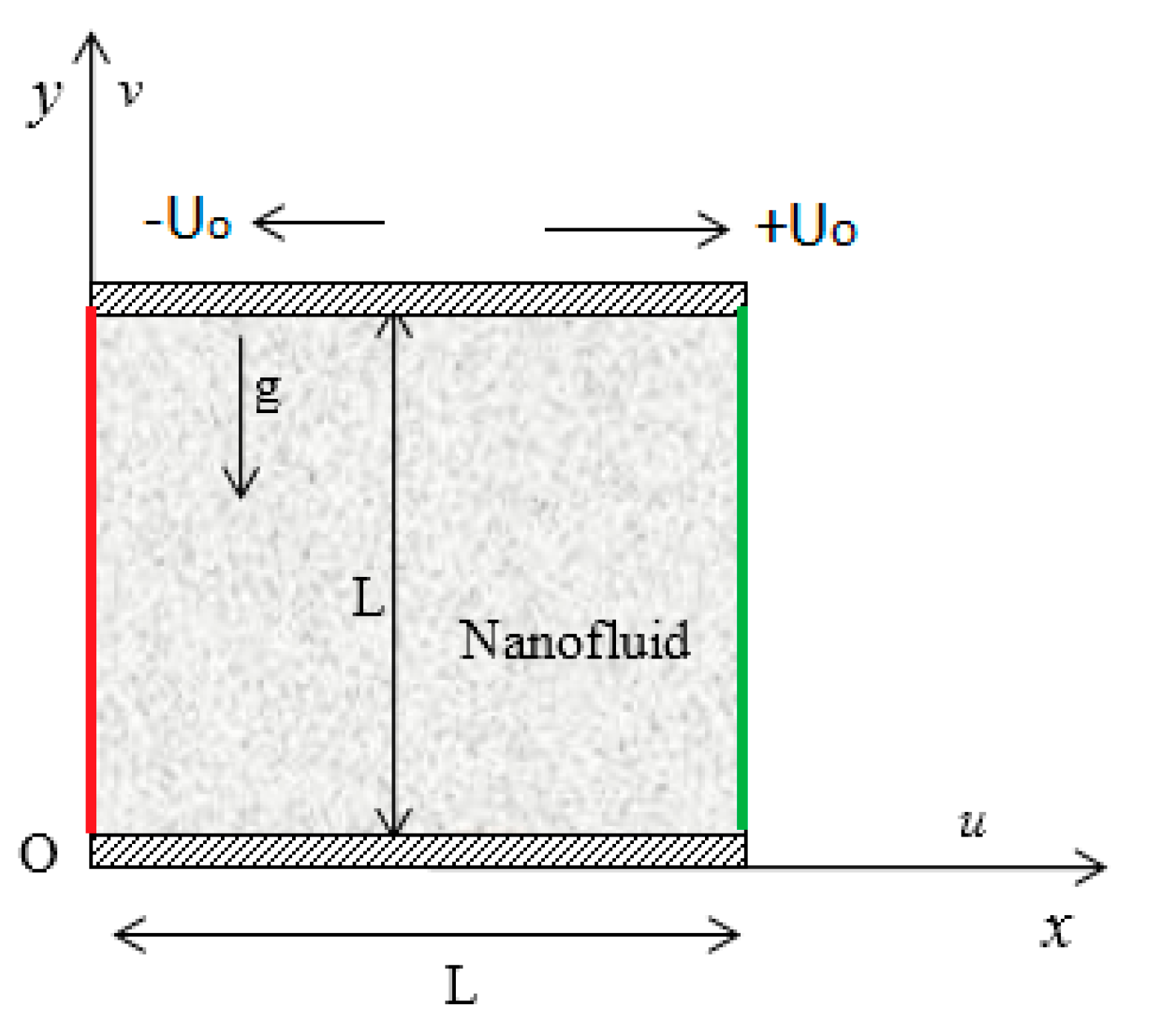



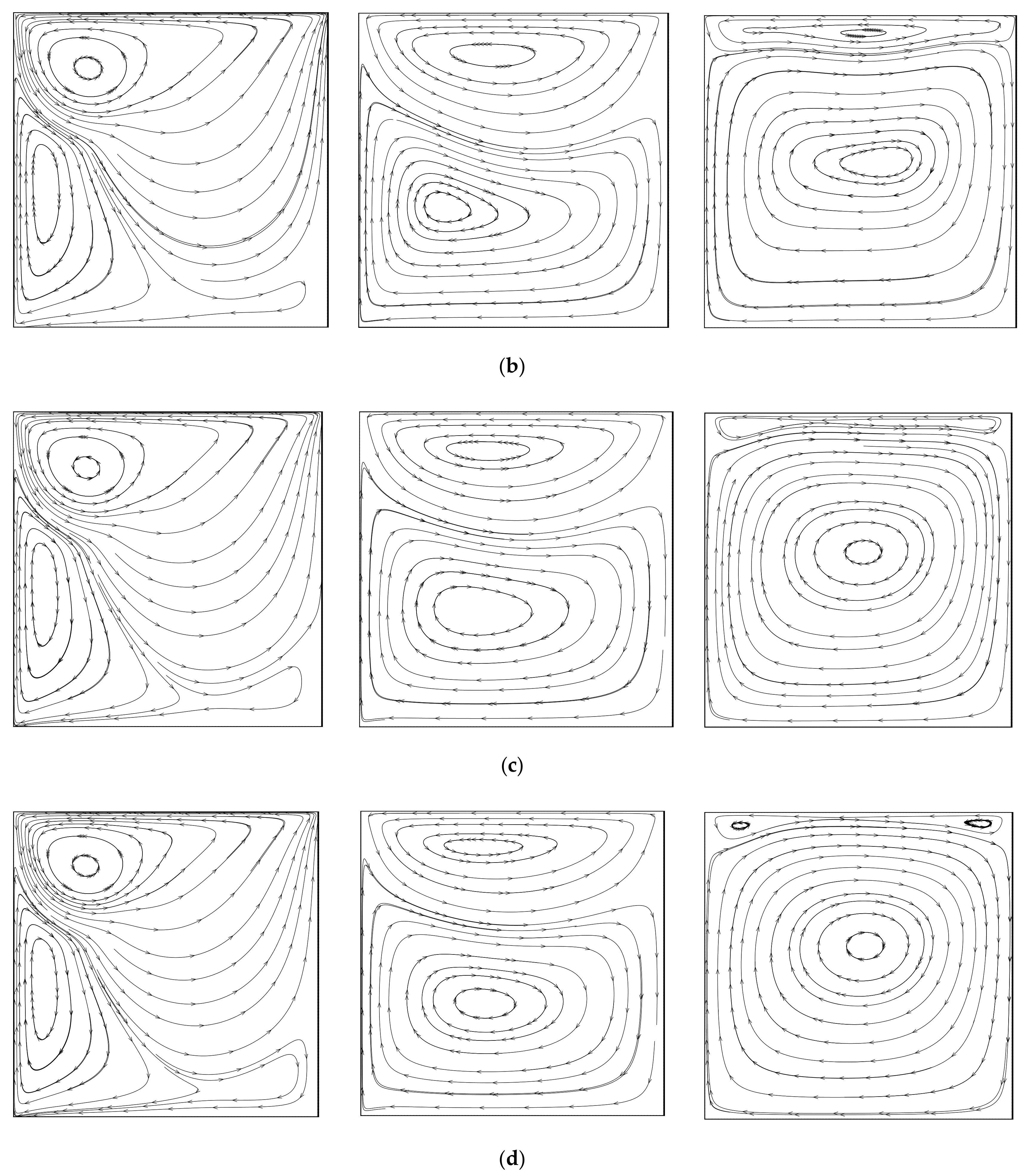
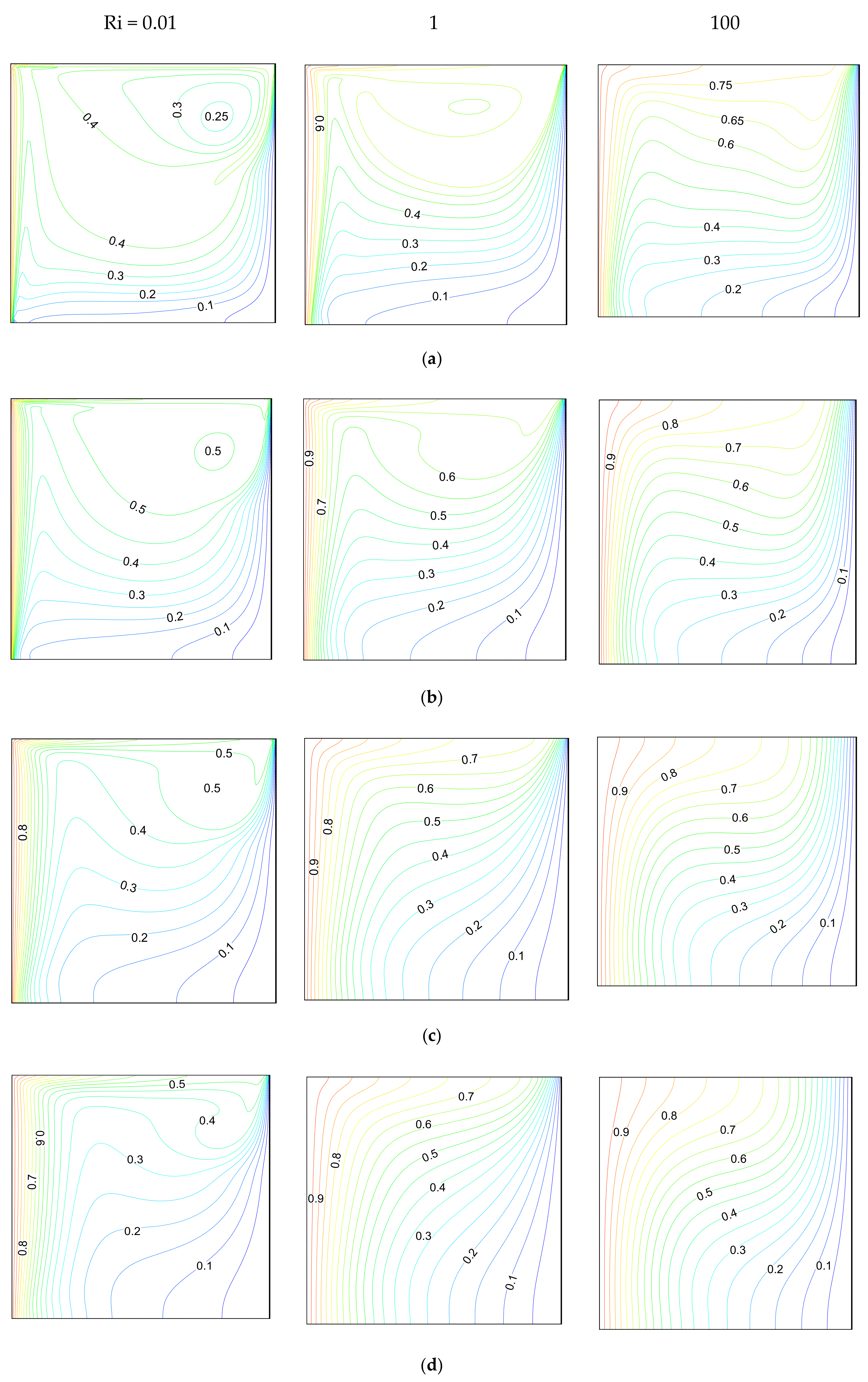
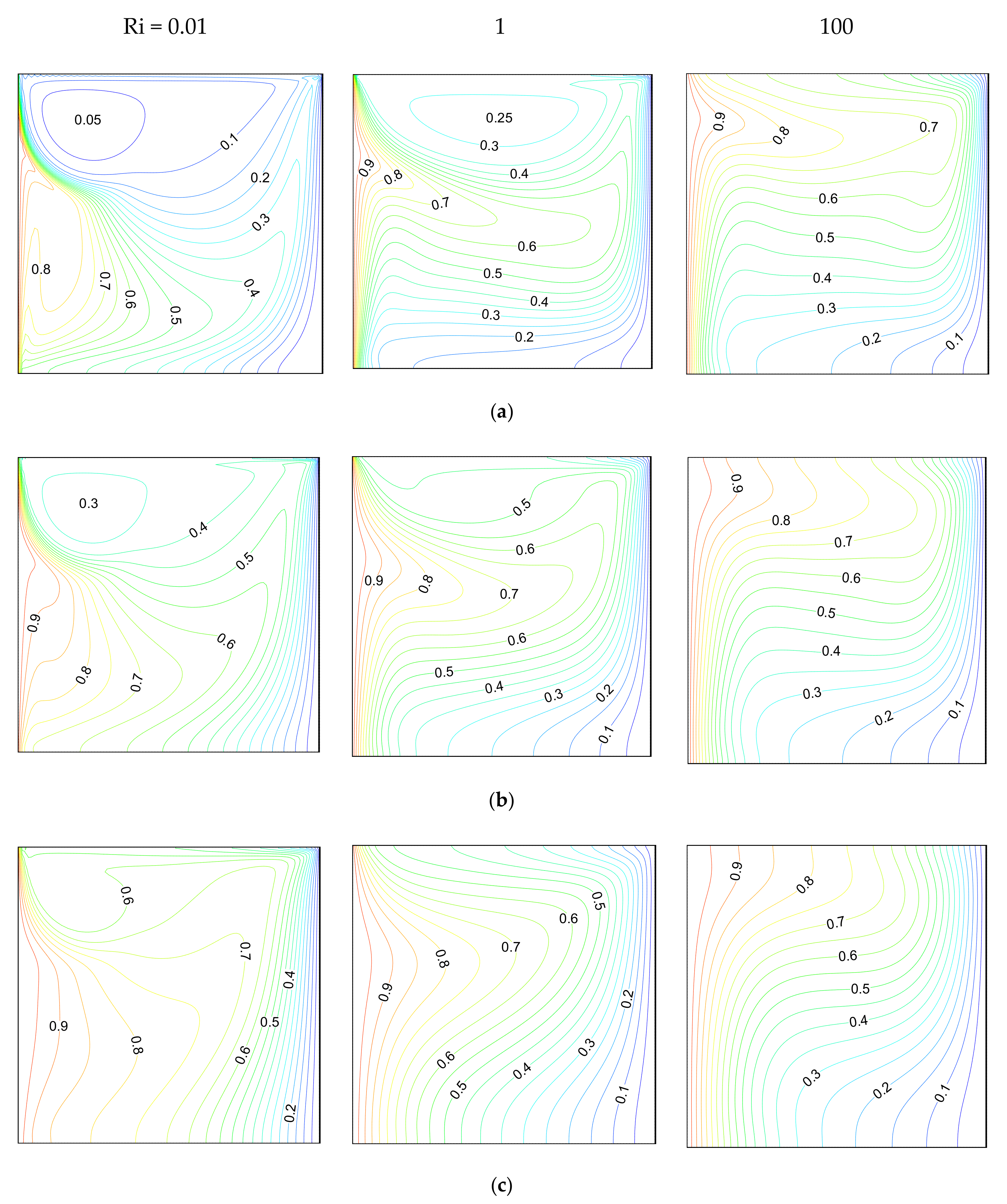


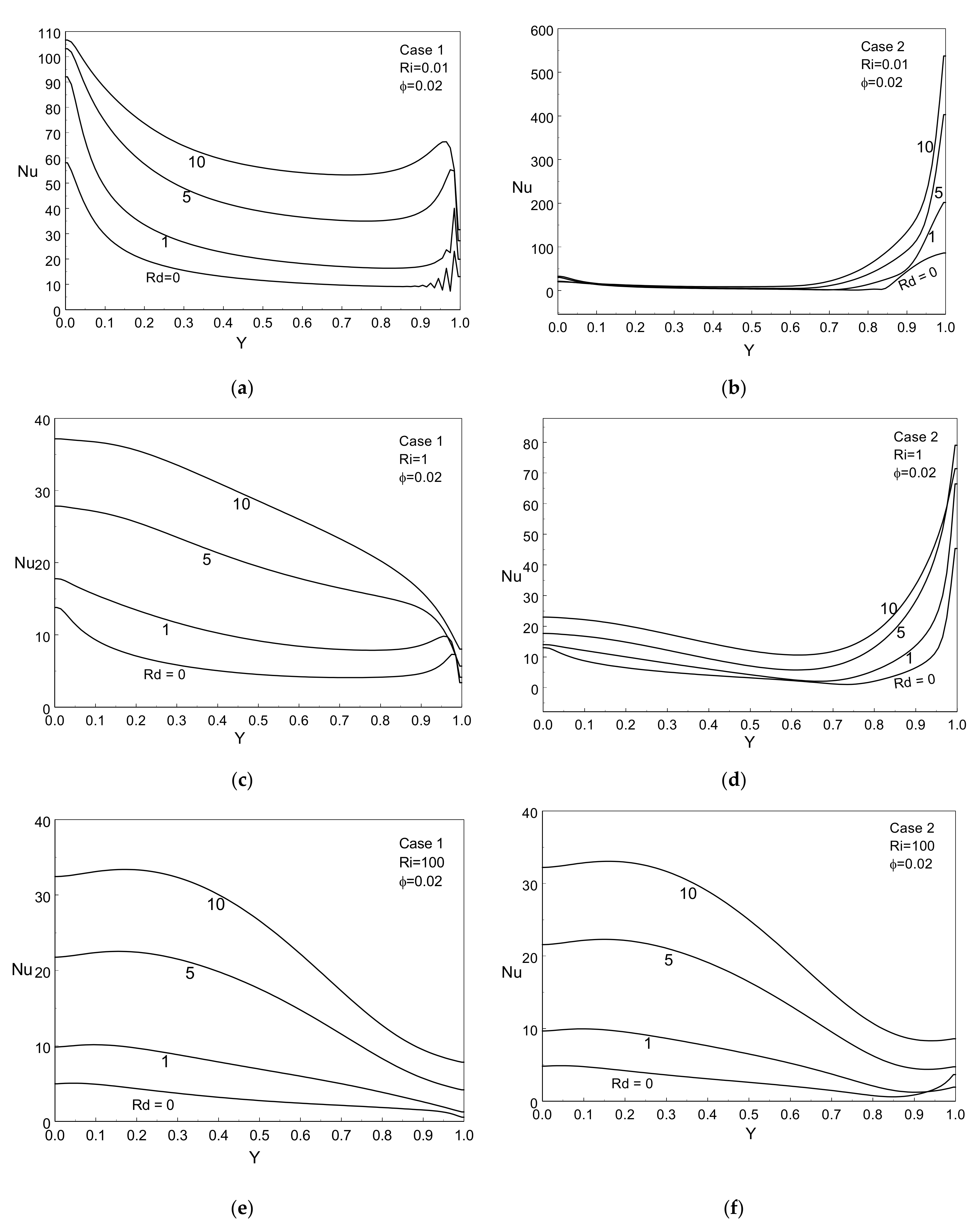



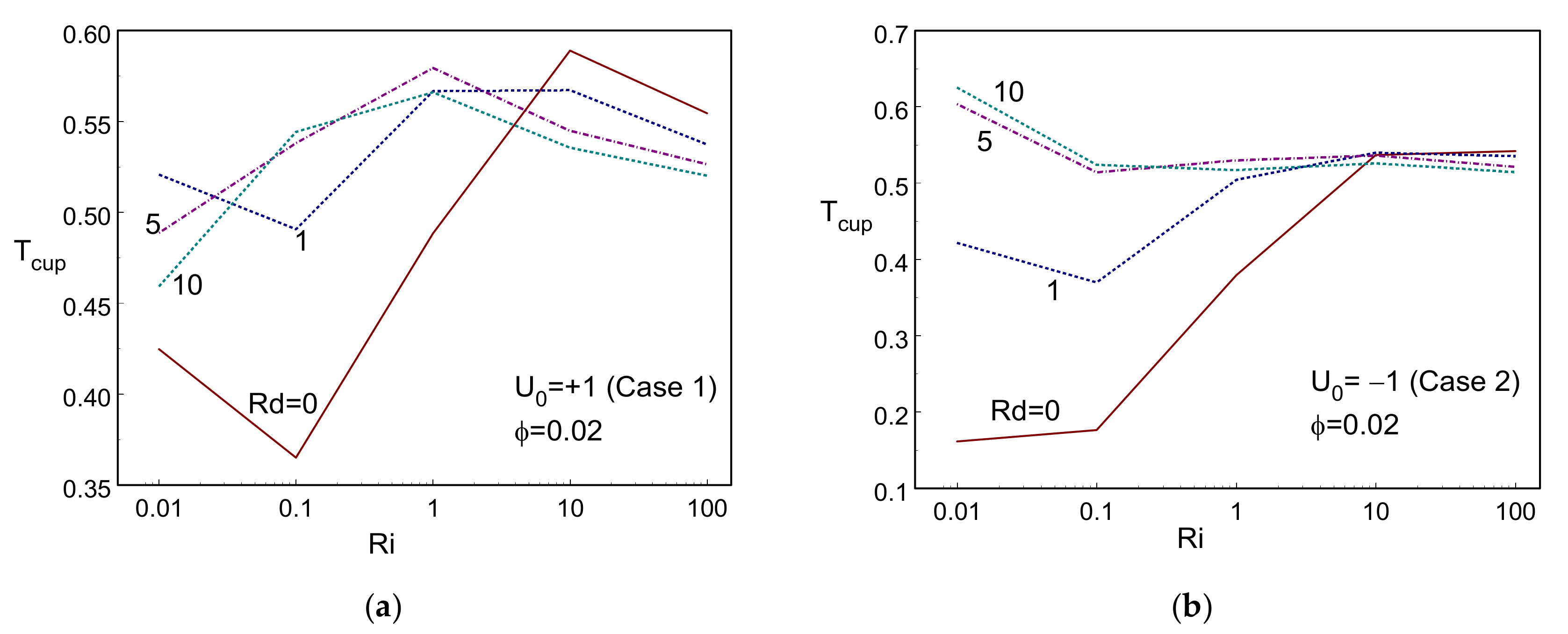




| Ra (Rayleigh Number) | Volume Fraction | ||
|---|---|---|---|
| Ho et al. [35] | Present | ||
| 103 | 0.01 | 1.129 | 1.137 |
| 0.04 | 1.199 | 1.205 | |
| 104 | 0.01 | 2.264 | 2.229 |
| 0.04 | 2.305 | 2.335 | |
| 105 | 0.01 | 4.699 | 4.683 |
| 0.04 | 4.810 | 4.791 | |
| 106 | 0.01 | 9.165 | 9.170 |
| 0.04 | 9.428 | 9.513 | |
© 2020 by the authors. Licensee MDPI, Basel, Switzerland. This article is an open access article distributed under the terms and conditions of the Creative Commons Attribution (CC BY) license (http://creativecommons.org/licenses/by/4.0/).
Share and Cite
Sivanandam, S.; Chamkha, A.J.; M. Mallawi, F.O.; Alghamdi, M.S.; Alqahtani, A.M. Effects of Entropy Generation, Thermal Radiation and Moving-Wall Direction on Mixed Convective Flow of Nanofluid in an Enclosure. Mathematics 2020, 8, 1471. https://doi.org/10.3390/math8091471
Sivanandam S, Chamkha AJ, M. Mallawi FO, Alghamdi MS, Alqahtani AM. Effects of Entropy Generation, Thermal Radiation and Moving-Wall Direction on Mixed Convective Flow of Nanofluid in an Enclosure. Mathematics. 2020; 8(9):1471. https://doi.org/10.3390/math8091471
Chicago/Turabian StyleSivanandam, Sivasankaran, Ali J. Chamkha, Fouad O. M. Mallawi, Metib S. Alghamdi, and Aisha M. Alqahtani. 2020. "Effects of Entropy Generation, Thermal Radiation and Moving-Wall Direction on Mixed Convective Flow of Nanofluid in an Enclosure" Mathematics 8, no. 9: 1471. https://doi.org/10.3390/math8091471
APA StyleSivanandam, S., Chamkha, A. J., M. Mallawi, F. O., Alghamdi, M. S., & Alqahtani, A. M. (2020). Effects of Entropy Generation, Thermal Radiation and Moving-Wall Direction on Mixed Convective Flow of Nanofluid in an Enclosure. Mathematics, 8(9), 1471. https://doi.org/10.3390/math8091471






